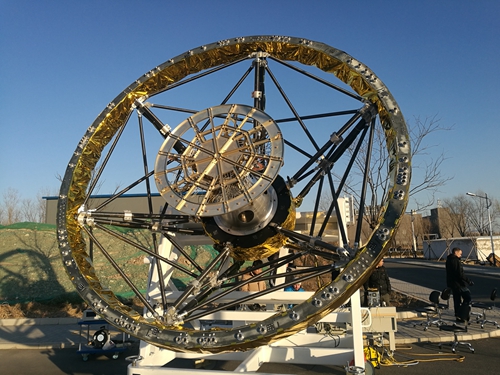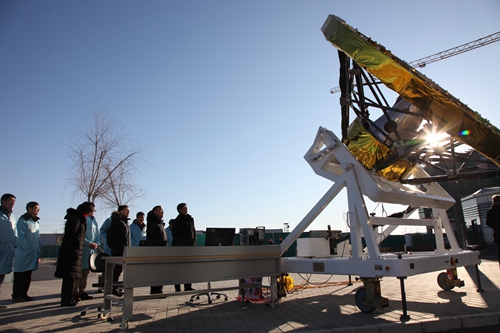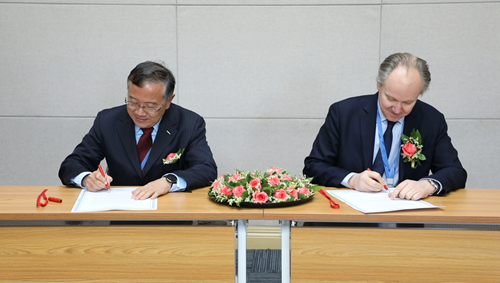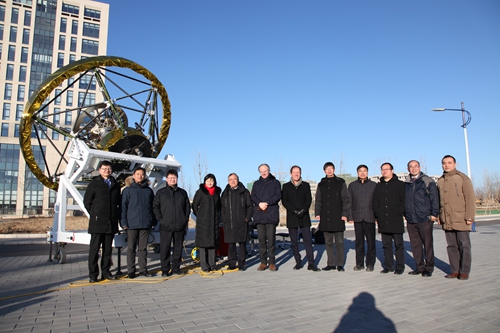The Joint Acceptance Ceremony of NSSC-ESA Geostationary Millimeter-wave Atmospheric Sounder Demonstrator held in Beijing
On Jan. 11, 2018, the Geostationary Millimeter-wave Atmospheric Sounder Demonstrator jointly developed by the National Space Science Center, Chinese Academy of Sciences (NSSC, CAS) and the European Space Agency (ESA) passed the Joint Acceptance Review, which is the first substantial achievement for CAS-ESA cooperation in the field of advanced payload technology of earth observation, paving the way for future Millimeter-wave exploration for the Chinese GEO meteorological satellites.
Geostationary Millimeter-wave Atmospheric Sounding can realize real-time three-dimensional monitoring of disastrous severe convection weather, such as typhoon and rain storms, as introduced by Prof. WU Ji from NSSC, CAS. At present, no meteorological satellites in the world have such observational capability. Therefore it is one of the most important research frontiers in the field of Earth observation all over the world. Of one accord, NSSC and ESA focus on the new interferometric aperture synthesis technology, aiming to tackle constrains of the traditional technology to achieve better technological specification such as better spatial resolution. After more than ten years of extensive research, both sides have entered the stage of developing full scale ground demonstrators for experimentation.

It was found that the Chinese and European concepts are highly complementary and could be merged, enhancing the performance beyond a threshold that makes it very attractive for the data users. The joint instrument will increase the feasibility and usefulness of the main payload of the next generation geostationary meteorological satellite mission.
NSSC and ESA reached an agreement to build a joint ground-based demonstrator, consisting of a 53 GHz channel provided by NSSC and a 183 GHz channel provided by ESA. Preliminary design review (PDR) for the joint demonstrator has been held in ESTEC, the Netherlands at Jan. 2015. Detailed design review (DDR) has been held in NSSC, Beijing, China at Dec. 8 2015. The 53GHz GIMS demonstrator and the 183GHz GAIS demonstrator has been separately integrated and tested in 2017.
The Test Readiness Review (TRR) for the joint demonstrator has been held in Gothenburg, Sweden in Oct. 2017. Two months later, the European GAIS demonstrator has been delivered to China and integrated together with GIMS demonstrator. Joint performance evaluation tests and joint imaging tests have been successfully conducted at NSSC Headquarters in Huairou. This ground-based joint demonstration verifies the feasibility of the joint instrument concept and paves the way for future space mission.

NSSC maintains close relations with ESA in the cooperation of space science missions. Starting from "Double Star and Cluster Mission" in the late 90s to the ongoing SMILE Mission, an ESA-CAS joint scientific mission, the in-depth cooperation has assumed momentum. The Geostationary Millimeter-wave Atmospheric Sounder is another living example of the increasingly extensive and in-depth bilateral cooperation.
Karl Bergquist, Administrator from international relations department of European Space Agency deemed the Geostationary Millimeter-wave Atmospheric Sounder Demonstrator as an integral part of strategic ESA-China cooperation in space technology.
The joint China-ESA Geostationary Millimeter-wave Atmospheric Sounder Demonstrator paves the way for the new generation meteorological satellites in China and Europe, especially for the geostationary meteorological satellites to achieve the 3D imaging of the atmosphere. It also laid a solid technical foundation to lead the international meteorological satellite development.




